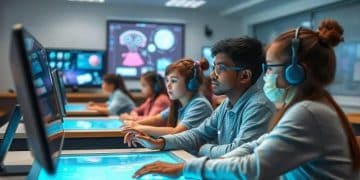K‑12 microlearning surge in hybrid classrooms 2025

K‑12 microlearning in hybrid classrooms enhances student engagement and retention by delivering content in short, interactive segments that accommodate diverse learning styles and flexibility.
K‑12 microlearning surge in hybrid classrooms 2025 is reshaping education, making learning more engaging and accessible. But what does this mean for students and teachers? Let’s delve into its impact.
Understanding K‑12 microlearning
Understanding K‑12 microlearning is essential for educators looking to enhance the learning experience in hybrid classrooms. This innovative approach focuses on delivering content in concise, easily digestible segments, allowing students to learn at their own pace.
The main idea behind microlearning is to break information into smaller bites. By doing this, students can engage with the material more effectively. Microlearning can be applied through various formats such as videos, quizzes, and interactive lessons.
Key Features of K‑12 Microlearning
There are several key features that make K‑12 microlearning unique:
- Short Learning Segments: Lessons are brief, often lasting just a few minutes, making it easier for students to focus.
- Flexible Learning: Students can access content anytime and anywhere, making learning more adaptable to their schedules.
- Engaging Formats: Microlearning incorporates videos, infographics, and interactive tools to keep learners engaged.
- Immediate Feedback: Quizzes and interactive exercises provide instant feedback, enhancing understanding and retention.
Furthermore, integrating microlearning in hybrid classrooms promotes a blended learning environment. This combination of digital content and classroom activities allows students to apply what they have learned immediately. For example, after watching a short video on a math concept, students can practice problems in class, reinforcing their understanding.
As educators adopt microlearning, they find that students exhibit increased motivation. The ability to learn in small chunks helps students to manage their time effectively. Moreover, this approach caters to various learning styles, ensuring that all students can grasp the material.
In summary, understanding K‑12 microlearning is about recognizing its benefits and applications. This approach not only makes learning more effective but also provides a flexible framework for students and teachers in hybrid settings.
Benefits of microlearning in hybrid settings

The benefits of microlearning in hybrid settings are numerous and impactful for both students and educators. This teaching method optimizes learning, making it adaptable and engaging in various environments.
One primary advantage is flexibility. Microlearning allows students to access resources at their own pace, helping them learn when they are most comfortable. This structure is perfect for hybrid classrooms where students may switch between online and in-person learning.
Enhancing Engagement
Incorporating microlearning can significantly enhance student engagement. Interactive lessons in small increments help keep students focused and motivated.
- Immediate Access: Students can quickly access lessons when they need them, minimizing frustration.
- Diverse Formats: Lessons can be provided through videos, quizzes, or simulations, catering to different learning styles.
- Quick Reinforcement: Microlearning helps students reinforce what they have learned immediately through practice.
Additionally, this method enables teachers to monitor progress in real-time. They can evaluate how well students understand concepts and adjust their teaching strategies accordingly. This responsive approach creates a more personalized learning experience.
Another benefit is improved retention. Research shows that short, focused lessons help students remember information longer. When knowledge is broken into smaller pieces, students can better recall it later. It also reduces cognitive overload, allowing for a stronger grasp of the material.
Furthermore, microlearning encourages collaborative learning. Students can work together in small groups, engaging in discussions and sharing insights. This collaboration fosters a sense of community, which is vital in a hybrid environment.
Ultimately, by embracing the benefits of microlearning in hybrid settings, educators can create a more effective and enjoyable learning atmosphere. This approach not only enhances retention and engagement but also ensures all students have the opportunity to succeed.
Strategies for effective microlearning implementation
Strategies for effective microlearning implementation are essential for educators who aim to enhance student learning. These strategies ensure that microlearning is not just a trend but an effective educational method.
One effective strategy is to define clear learning outcomes. Educators should identify what students need to achieve at the end of each microlearning session. This clarity helps students focus on the goals and understand the significance of the material being taught.
Choosing the Right Content
Another crucial aspect is selecting appropriate content. The material should be relevant and engaging to capture students’ interest. Using a mix of formats, like videos, articles, and quizzes, can cater to diverse learning styles.
- Interactive Elements: Incorporate elements like quizzes and polls to engage students actively.
- Storytelling: Use storytelling techniques to make content relatable and memorable.
- Real-World Applications: Provide examples that link lessons to real-world scenarios for better understanding.
Technology plays a significant role in microlearning. Utilizing platforms that offer mobile-friendly content allows students to access learning materials anytime, enhancing flexibility. This accessibility is vital in hybrid environments where students may be learning from different locations.
In addition, frequent assessments can reinforce learning. Short quizzes after each microlearning session help gauge comprehension and allow students to track their progress. Instant feedback is beneficial as it guides their learning journey.
Collaboration among students is another strategy to enhance effectiveness. Group activities encourage discussion and peer learning, which can deepen understanding of the content. Incorporating discussions into microlearning can also provide social interaction, which is important for student engagement.
Ultimately, employing these strategies for effective microlearning implementation can significantly improve educational outcomes. By focusing on clear goals, engaging content, and leveraging technology, educators can create a dynamic learning experience.
Challenges and solutions in hybrid classrooms

The challenges and solutions in hybrid classrooms are critical areas that educators need to understand. Hybrid learning presents unique difficulties that require innovative strategies to overcome.
One major challenge is ensuring all students are equally engaged. In a hybrid setting, some students learn online while others are in-person. This can lead to feelings of isolation for remote learners. To address this, instructors can use interactive tools like video conferencing and online chat platforms. These tools help bridge the gap between in-person and online students, fostering communication and collaboration.
Maintaining Student Motivation
Another obstacle is keeping students motivated. Remote learning can sometimes feel less engaging than traditional classroom settings. To combat this, teachers can incorporate more hands-on activities and gamified lessons. Making learning fun can spark interest and encourage participation.
- Interactive Assignments: Use projects that require collaboration between in-person and online students.
- Frequent Check-ins: Regularly ask for feedback from students to understand their needs.
- Varied Learning Materials: Utilize different formats such as videos, podcasts, and articles to cater to diverse preferences.
Technology also poses challenges. Not all students may have equal access to devices or reliable internet. To address this issue, schools can provide resources and tech support as needed. Flexible deadlines can also help accommodate students who may be struggling with access.
Time management stands out as another challenge. Teachers must balance coursework for in-person and online students, often complicating lesson planning. Implementing a clear schedule that outlines when each group will meet can help streamline the process. Digital calendars and reminders are tools that can aid in keeping everyone informed.
Ultimately, while there are clear challenges and solutions in hybrid classrooms, proactive strategies can create effective and engaging learning environments. By focusing on communication, motivation, and technology, educators can navigate the complexities of hybrid learning successfully.
FAQ – Frequently Asked Questions about K‑12 Microlearning in Hybrid Classrooms
What is K‑12 microlearning?
K‑12 microlearning is a teaching approach that delivers content in small, bite-sized chunks, making it easier for students to understand and retain information.
How can microlearning enhance student engagement?
Microlearning uses interactive elements such as quizzes and videos, which can keep students more engaged and make learning fun.
What challenges does microlearning face in hybrid classrooms?
Challenges include ensuring equal engagement for remote and in-person students, maintaining motivation, and managing technology access.
What strategies can help implement microlearning effectively?
Strategies include setting clear learning outcomes, using varied content formats, frequent assessments, and fostering collaboration among students.





